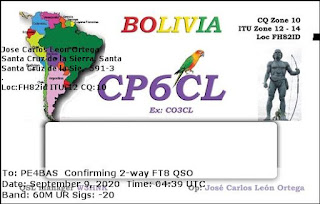What happened this year, was there any radio magic? Yes, absolutely, that's what I love in this hobby. There is always magic, unexpected things that happen. If it would not happen or, in other words, I would not see the magic anymore I don't think I was still into this hobby. January started with my digital portable project, I did get it working like it should though it is not as reliable as I wish. Especially the wireless CAT control is a problem. Besides that, some of the gear is battery powered. A better idea would be to power everything from the radio so you need only one battery to feed the whole station in the end. Enough to think about in the future. I also did a controversial post about QSL cards, it immidiatly attracted comments from international QSL managers who did not agree with the post. I don't blame them, it's part of the hobby especially for them. On the other hand I think it's good to think different and trigger some people. I'm shure I didn't get friends with the post but I don't really care. February brought one of the worst PACC contests in years for me, with a very low score....but surprisingly I won the biggest section SOAB Low
 |
| Summer 2020 |
SSB. I've been looking at another multiband antenna in March, one of my goals to construct it. But it didn't happen, I've been buying stuff for this antenna though, parts are waiting for...2021? I also created a worked all fellow bloggers post in April, updated it a few times this year and surprisingly already worked 20 fellow bloggers. The month of May was completely for the PE75FREE activation. I even managed to get 2 FT8 stations on air at the same time. In total worked 5424 QSOs in one month, a incredible amount I think for a modest station. A little late due to the activity in May I started with my next goal in June, building a yagi for DX on 4m. It became a duoband yagi by YU7EF. The result was incredible and I was still able to work on 6m as well. I worked 31 DXCC on 4m and got 10 new DXCC on 6m this year, a very successfull ES season for shure. Besides a lot of DX on 4m/6m and 60m this year I also did some homebrewing/modifying equipment. I finally finished the MFJ-948 to S-Match project and learned a lot about tuners in general. I also dived into the world of baluns which resulted in 2 baluns, one for high bands and one for low bands. Learned a lot about that as well. Well, 2020 was a interesting year for shure.
Did I meet my goals? Yes and no! No, I didn't build the new 5 band beam. And yes, I did activate 4m DX and build a antenna for this band. Do I have goals for 2021? Well, I always like to experiment with antennas. I'm thinking about a separate receive antenna for ages, I might try a loop on ground project? I will continue DX on 60m, 6m and 4m of course and plan to get the antenna up early in the ES season before I miss some DX again. If time allows I might even have time to continue with the 5 band quad build. Then the new HF Ultra-Marathon is very appealing, I think I will participate. We'll see how things go...
And now, my dear readers, I wish you all much health. Stay safe...
 |
| @PE4BAS shack dec. 2020 |

















































